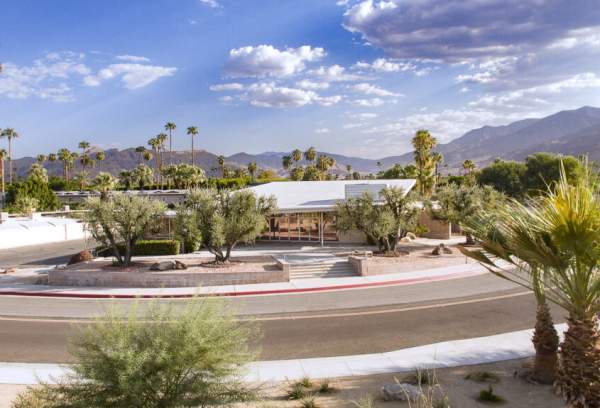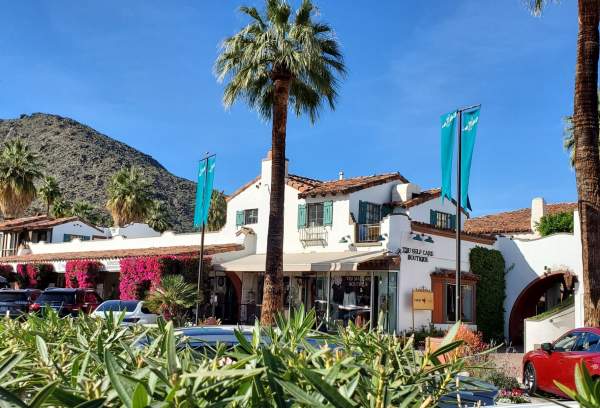Shaping a Desert Oasis
Journey through the history of Palm Springs, where we spotlight the remarkable women pioneers who have left an indelible mark on this desert oasis. These women helped shape the landscape of Palm Springs with their tenacity and creativity. We celebrate their stories, achievements, and lasting impact on this vibrant community. Get ready to be inspired by the incredible legacy of the Women Pioneers of Palm Springs.
Nellie Coffman & The Desert Inn
In 1909, she and her husband, Dr. Harry Coffman, moved to the desert town seeking a healthier climate for his tuberculosis. Little did they know that their arrival would mark the beginning of a legacy that would forever change the landscape of Palm Springs.
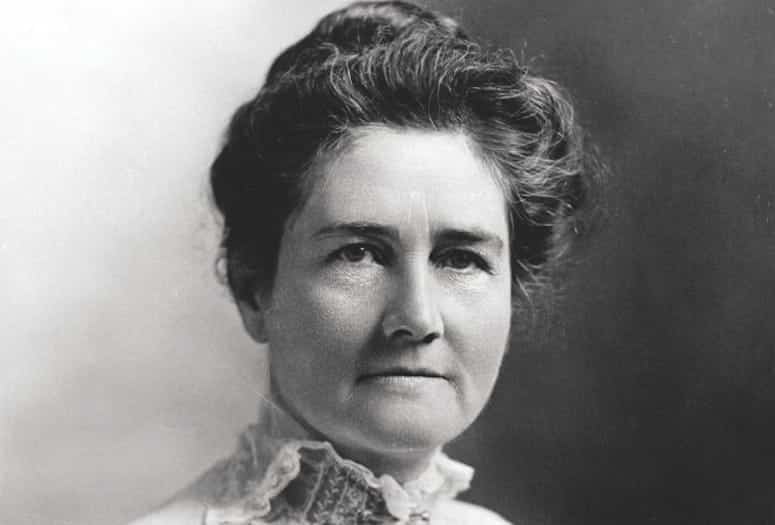
One of Nellie Coffman's most significant contributions to the city was the establishment of the Desert Inn, a hotel that quickly became a social hub for residents and visitors alike. What started as a small adobe boarding house became a prestigious resort under Nellie's guidance. The Desert Inn attracted celebrities, politicians, and socialites, putting Palm Springs on the map as a fashionable and upscale destination.
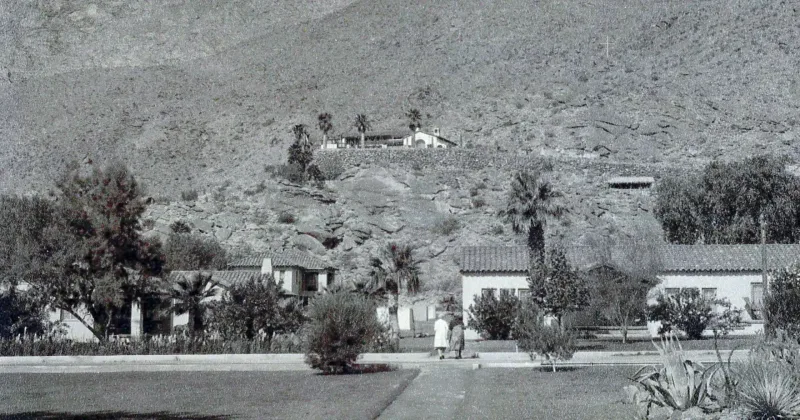
Beyond her role as a hotelier, Nellie Coffman was also a philanthropist and community leader. Those in need knew her for her generosity, often providing food, shelter, and medical care. During the Great Depression, she opened her doors to the unemployed, offering them a place to stay and meals to sustain them during difficult times. She founded the Palm Springs Welfare and Friendly Aid, which eventually became the local United Way.
Today, Nellie Coffman's legacy lives on in the vibrant city of Palm Springs. Her pioneering spirit, compassion, and dedication to the community have left an indelible mark on the desert town she called home.
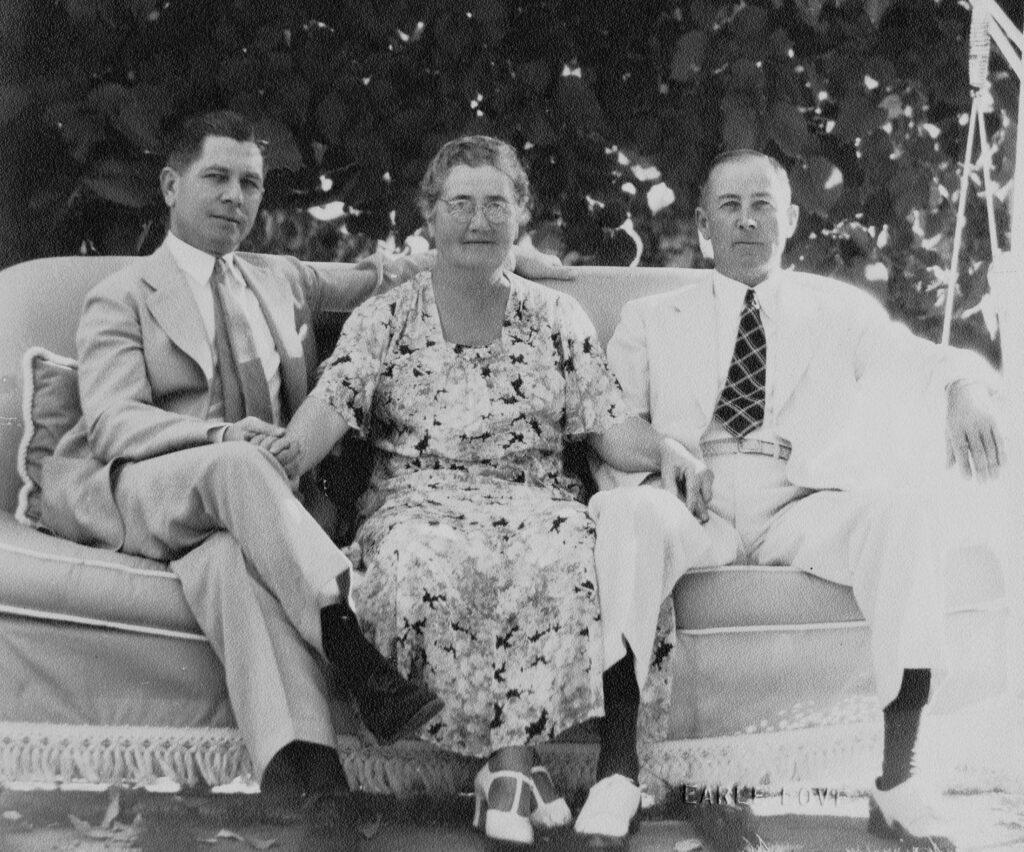
Earl Coffman, Nellie Coffman and George Roberson circa 1926. Photo Courtesy Palm Springs Historical Society.
Pearl McManus: A Trailblazing Pioneer
A true pioneer, Pearl McManus was not only astute in real estate dealings but also profoundly connected to Pearl McCallum McManus, a formidable and visionary woman who left an indelible mark on the vibrant desert oasis of Palm Springs. Her contributions spanned real estate, architecture, and community development, shaping the city’s identity and ensuring its enduring legacy.
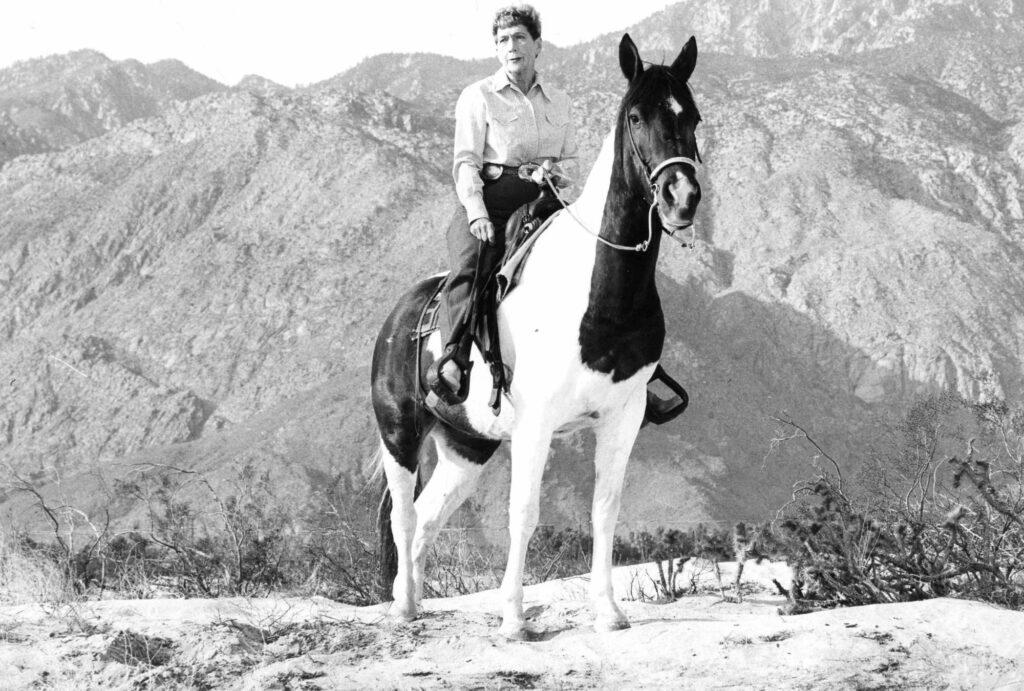
Early Life and Inheritance
Pearl was born into the McCallum family, a name synonymous with Palm Springs history. After her mother’s passing in 1914, she inherited the McCallum holdings, which included 5,000 to 6,000 acres of land. Despite the initial devaluation of the property, Pearl’s determination and business acumen allowed her to capitalize on her father’s vision and create a lasting impact.
Real Estate Dynasty
At age 26, Pearl returned to Palm Springs, where she met and married Austin McManus, a real estate agent. Together, they founded Pioneer Realty, with Pearl as president and Austin as secretary. Their complementary skills—Pearl’s unwavering negotiation prowess and Austin’s charismatic charm—propelled them to success. Pearl’s insistence on reversible property deeds for architectural reasons and restrictive covenants on land use demonstrated her forward-thinking approach.
Architectural Innovation
In 1924, McManus recognized the need for another hotel in Palm Springs. They enlisted the estranged son of Frank Lloyd Wright, Lloyd Wright, to design an art deco tower that would redefine architectural standards in the downtown area. The Oasis Hotel broke away from the traditional Spanish Colonial style. Pearl incorporated her father’s ranch building into the design, creating a harmonious blend of past and present. The result was a landmark that set a new standard for quality. While the hotel was demolished, the tower remains.


The Tennis Club
Pearl’s vision extended beyond real estate. She transformed her English visitors’ desire for tennis courts into a grand project—the Palm Springs Tennis Club. The club featured exquisite courts, considered among the finest globally, and an oval pool framed by graceful palm trees. The pool’s design was so striking that it appeared in the State Chamber of Commerce’s promotional literature. Additionally, Pearl enlarged an old irrigation ditch, turning it into a rippling stream stocked with trout. Guests could catch their dinners while enjoying the shade of mesquite trees.
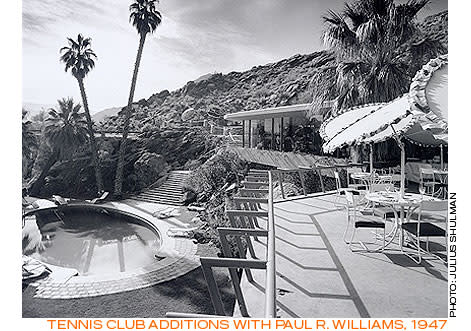
Legacy and Philanthropy
Pearl McManus’s legacy extends beyond bricks and mortar. She established the McCallum Desert Foundation in honor of her father, ensuring his recognition as a founding figure in Palm Springs. Her charitable endeavors reflected her commitment to community welfare.
Pearl McCallum McManus remains an icon—a woman who defied conventions, shaped landscapes, and left an indelible imprint on the desert paradise she loved. Her story is woven into the very fabric of Palm Springs, a testament to her enduring influence.
Zaddie Bunker: Breaking Barriers
Zaddie Dawson, later known as Zaddie Bunker, began her journey in the heart of Missouri. She met and married Ed Bunker, and together with their daughter, Frances, they embarked on an adventurous move to California. Their trusty two-cylinder Austin was transformed into a makeshift pickup truck by removing the back seat, allowing them to transport their belongings westward.
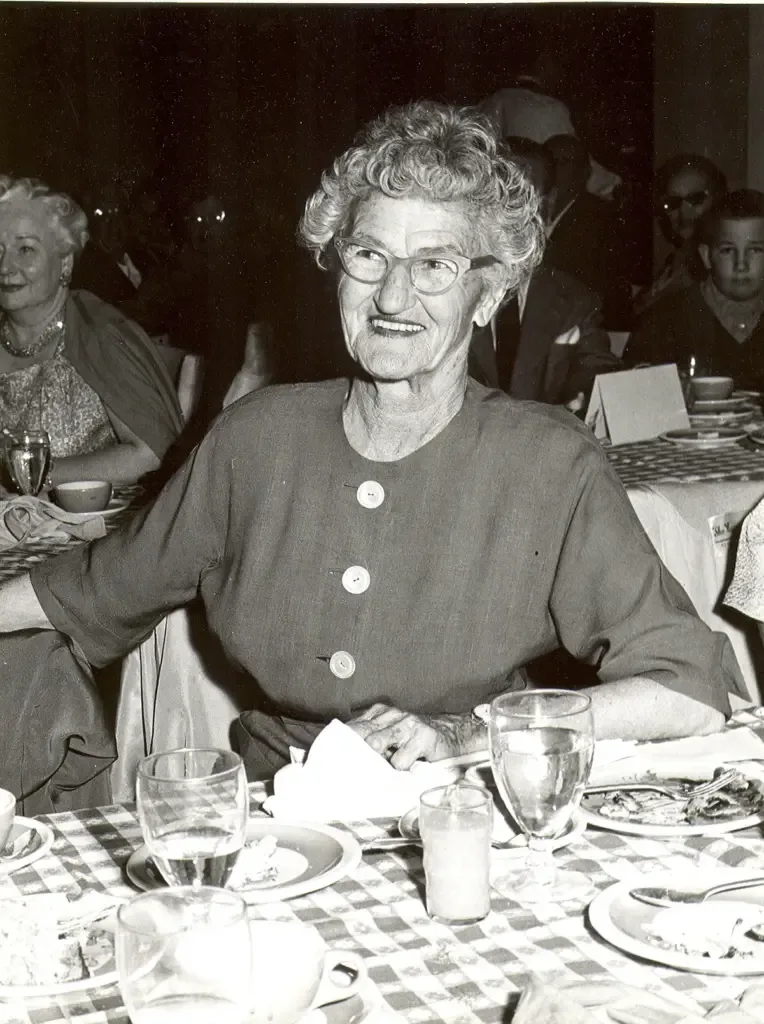
From Potatoes to Automobiles
The Bunkers initially rented 1,000 acres in San Jacinto, where they planted potatoes. However, the potato market proved challenging, and a harsh winter freeze ruined their crop. Undeterred, they seized an opportunity: the county had just approved bonds to pave the highway from Banning to Indio. Recognizing the potential, they established an automobile repair garage in Palm Springs.
After completing an auto repair correspondence course, Zaddie and Ed arrived in Palm Springs. In 1914, they opened Bunker’s Garage, despite the town having only three cars. Their tent house, with hardwood floors and wood walls covered by a canvas roof, served as the garage. Ed worked tirelessly for 25 cents an hour, taking on various tasks for builder Alvah Hicks, while Zaddie sewed for Nellie Coffman, owner of the Desert Inn.
Breaking Barriers
Zaddie Bunker’s resourcefulness extended beyond auto repair. She became California’s first woman to obtain a chauffeur’s license. She transported tourists and goods from the train station into town using her makeshift pickup truck. Her entrepreneurial spirit led her to acquire parcels of land along Main Street (now Palm Canyon Drive) in the early 1920s.
Remarkably, at 65, she earned her private pilot’s license and embarked on a solo flight across the United States. Her fascination with aviation knew no bounds.
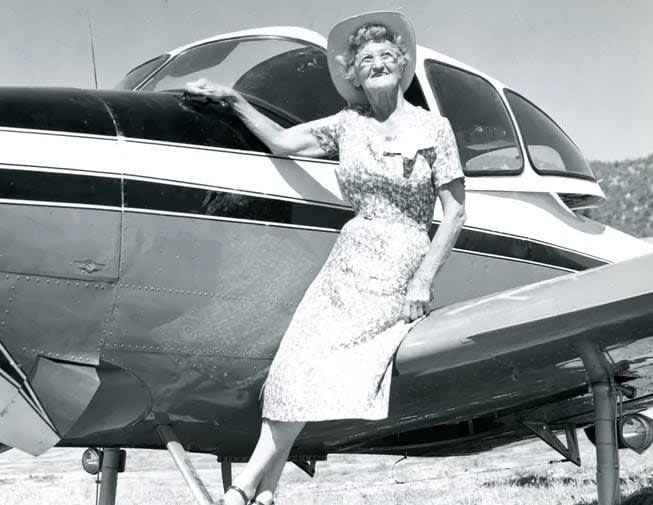
Shaping Palm Springs
Bunker’s Garage: The repair shop she co-founded played a crucial role in the town’s early automotive industry.
Real Estate Development: The Bunkers acquired land on Main Street, contributing to the city’s growth.
Village Theatre: Zaddie developed the Village Theatre, a cultural hub for entertainment.
Chi Chi Nightclub: She also helped create the Chi Chi nightclub, a hotspot for socializing.
Aero Palm Springs Company: In 1952, she founded Aero Palm Springs, which operated the local airport.
Zaddie Bunker’s legacy lives on as a trailblazer, a woman who defied conventions and shaped the destiny of Palm Springs. Her vision, tenacity, and resourcefulness continue to inspire generations, reminding us that sometimes the most significant contributions come from the unsung heroes.
Ruth Hardy: A Visionary
As Palm Springs’ first city councilwoman, Ruth Hardy left an enduring legacy. Born determined and keen for progress, she arrived in Palm Springs with her husband, Jack, ready to make a difference. Little did they know that their path would intersect with destiny.
City Councilwoman and Hotelier
In the 1940s, Ruth Hardy became one of the female pioneers who transformed Palm Springs into the world-renowned resort destination we know today. Alongside trailblazers like Pearl McCallum, Nellie Coffman, and Julia Carnell, Hardy left an indelible legacy. Her impact extended beyond the picturesque desert landscape; it reached the heart of the community.
As a Palm Springs City Councilwoman, Ruth Hardy championed progressive ideas. Her vision extended far beyond the horizon, and she believed in turning dreams into reality. But it wasn’t just about legislation; it was about creating an oasis of beauty and charm.
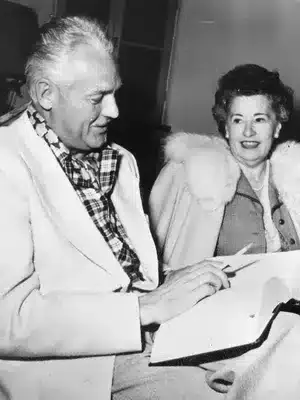
Mayor Charlie Farrell and Ruth Hardy. Courtesy: Palm Springs Historical Society.
The Iconic Palm Trees of Palm Canyon
Imagine Palm Canyon without its iconic palm trees lining the streets. In the summer of 1949, she proposed a bold idea: to plant palm trees along the city’s downtown thoroughfare. The town embraced her vision, and 300 palm trees found their roots in the desert soil.
The chosen palms were the Washingtonia Filifera (Desert Fan Palms), indigenous to Palm Springs, and Washingtonia Robusta (Mexican Fan Palms). These majestic trees now stand tall, their fronds swaying in the desert breeze. The palms, slender and elegant, complement the harmonious skyline and mountain backdrop. These trees, resilient and enduring, symbolize the spirit of Palm Springs.
So, the next time you admire the palm trees lining Palm Canyon, remember to thank Ruth Hardy. Her pioneering spirit continues to shape the desert oasis we call home.
The Ingleside Inn: A Legacy
Ruth Hardy’s influence extended beyond city planning. She purchased the Birge estate, which she transformed into the Ingleside Inn, a 20-room luxury hotel. The Inn became a haven for an exclusive clientele, including luminaries like Ava Gardner, Greta Garbo, Howard Hughes, and Elizabeth Taylor. Ruth operated the hotel for decades, leaving an indelible mark on its history.
Ten years after her passing in 1965, the Inn changed hands, becoming the iconic Ingleside Inn, thanks to Mel Haber. The echoes of Ruth Hardy’s vision still resonate within its walls. Today, it is called the Ingleside Estate and includes Melvyn’s restaurant.
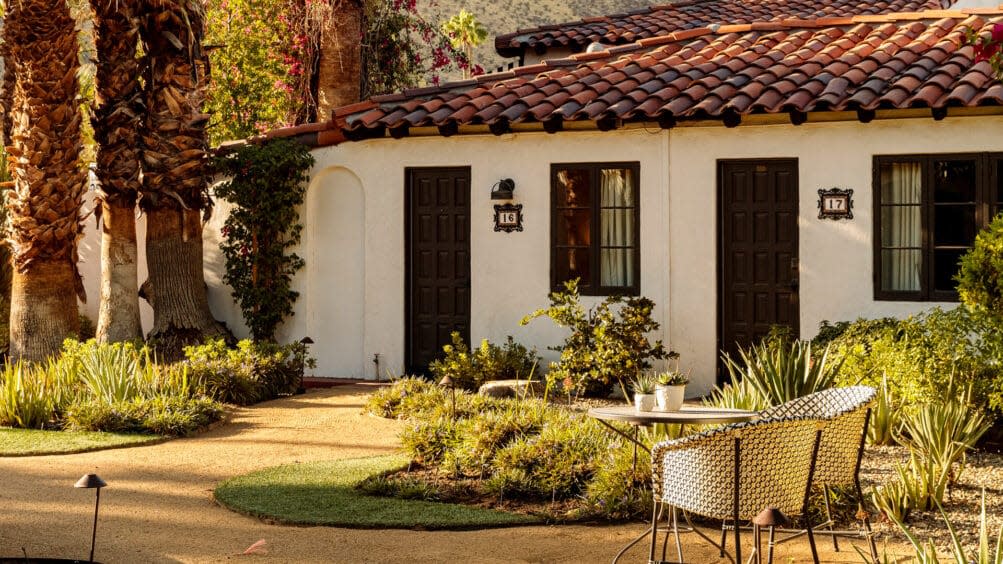
Ruth Hardy Park: A Tribute
The city’s largest park bears her name—Ruth Hardy Park. It’s more than just green space; it’s a testament to her unwavering commitment. As visitors stroll through the park, they unknowingly walk in the footsteps of a visionary. Ruth Hardy’s legacy lives on in the rustling palms and the hearts of those who cherish Palm Springs.
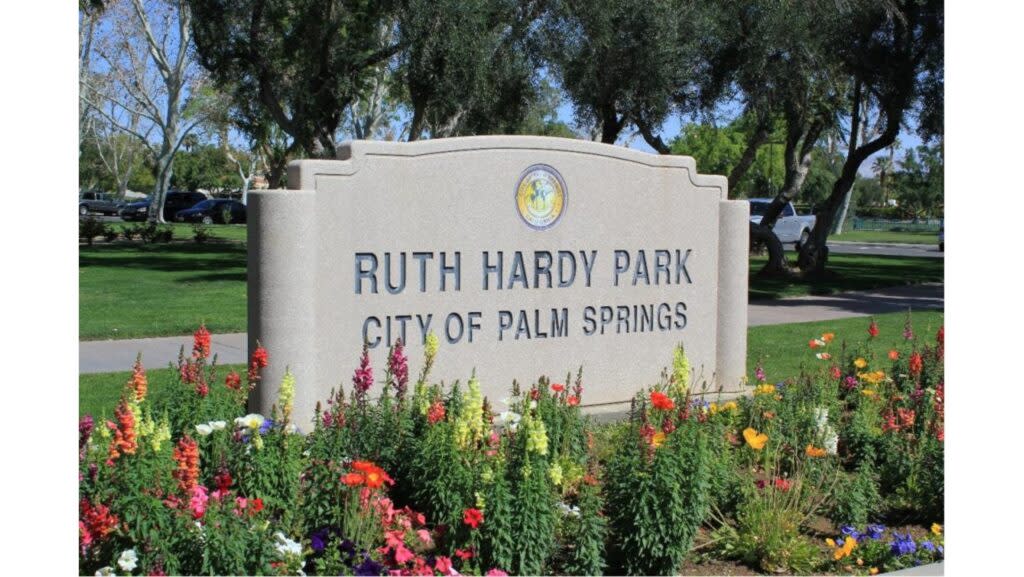
Women Pioneers of the Agua Caliente Tribe
The Agua Caliente Band of Cahuilla Indians boasts a rich history of remarkable women who shaped their community and secured long-term land leases. In 1954, five women created the first all-women Tribal Council.

LaVerne Saubel, Elizabeth Pete-Monk, Gloria Gillette, Vyola Ortner, Eileen Miguel
Vyola J. Ortner chaired the first all-women Tribal Council. She was a visionary leader who worked tirelessly alongside her fellow council members to advocate for the Agua Caliente people. Ortner’s dedication and political acumen helped pave the way for greater self-sufficiency and economic prosperity for the Tribe.
Ortner played a pivotal role in securing 99-year land leases for tribal lands. These leases provided stability and economic opportunities for the Agua Caliente Band of Cahuilla Indians. These efforts ensure the Tribe could benefit from sustainable land use and development.
Elizabeth Pete-Monk contributed significantly to the Agua Caliente community. Her commitment to preserving tribal heritage and securing long-term leases laid the groundwork for a brighter future. She also played a vital role in advocating for the tribe's constitution and bylaws, ensuring effective governance and stability.
LaVerne Saubel, the Vice Chairman of the all-women Tribal Council, played a crucial role in advocating for the Tribe’s rights and interests. She was part of the historic power shift that led to the first all-women Tribal Business Committee. She also advocated for a constitution and bylaws for the Tribe.
In September 1957, LaVerne faced a personal tragedy when her 30-year-old husband, James, was struck and killed by an automobile on Highway 111. Despite this loss, she continued to serve on the council, demonstrating resilience and unwavering dedication to her community.
Gloria Gillette brought a unique perspective and leadership style to the table. She was dedicated to tribal issues and her commitment to their welfare. In addition, she was also instrumental in promoting gender equality and representation within tribal leadership.
Eileen Miguel served as the Secretary of the all-women Tribal Council. Her administrative skills and leadership were invaluable. Miguel’s patience and persistence helped secure vital long-term leases, ensuring a stable future for the Agua Caliente people.
Cornelia White
Welwood Murray owned The Palm Springs Hotel, the first hotel in Palm Springs. Upon his death, Cornelia White and her sister, Florilla, purchased the house and property. They also purchased land south of Tahquitz, including her home, which was made of railroad ties. When Florilla died in 1943, Cornelia decided to sell 231 frontage feet on Indian Canyon extending north on Tahquitz. A portion of this last would be home to the Desert Museum and the Welwood Murray Memorial Library.
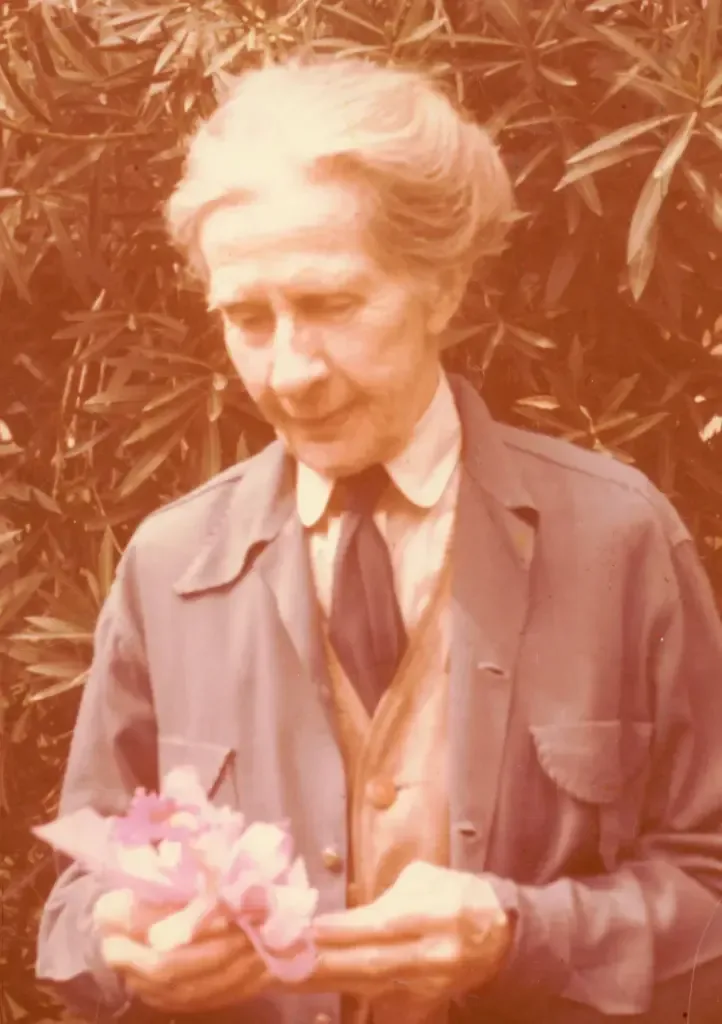
Cornelia has collected many art pieces and donated several artifacts to the museum, including Cahuilla pots, a kava bowl, and two rare rabbit-skin blankets made from countless skins of jackrabbits by the Washo Indians of Nevada.
Cornelia also sold land to Julia Carnell to build La Plaza.
You can visit the Cornelia White House at the Village Green.
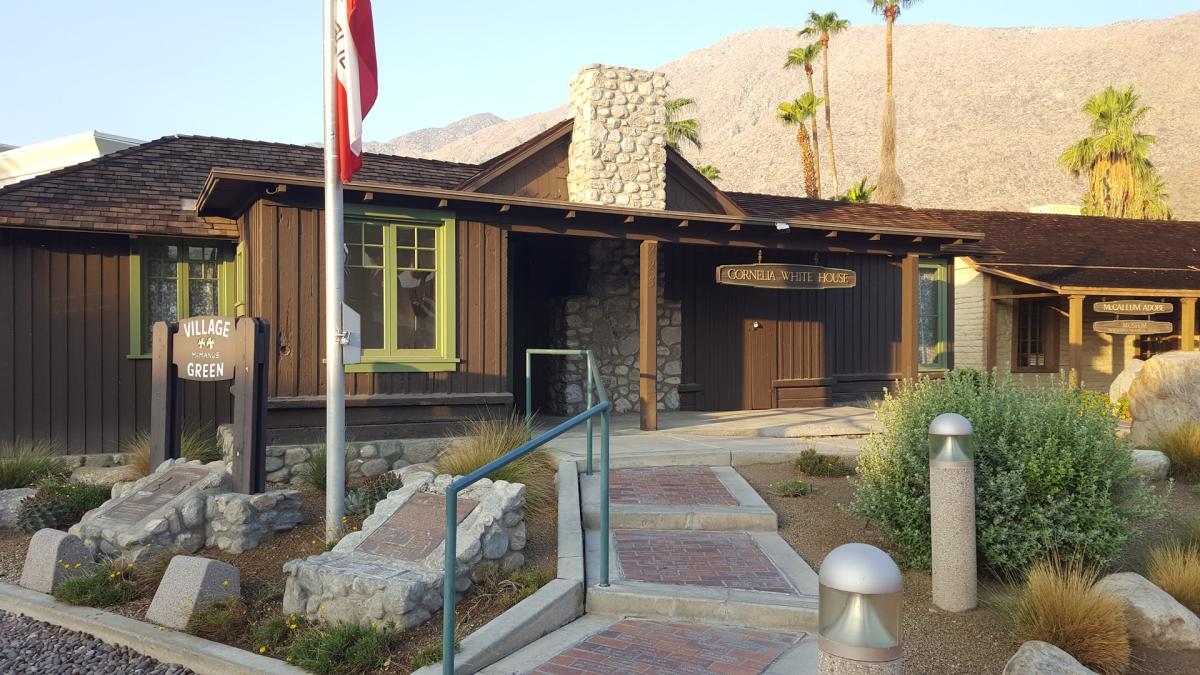
Harriet Cody
Harriet Cody was born into one of the wealthiest families in Philadelphia and was a direct descendant of Sir Thomas Moore. In 1910, she married the promising young architect Harold William (Bill) Bryant Cody, who worked for an architectural firm in San Francisco. Unfortunately, Bill contracted tuberculosis, prompting the couple to seek a warmer, drier climate for his recovery. Their journey led them to Southern California and eventually to Palm Springs.
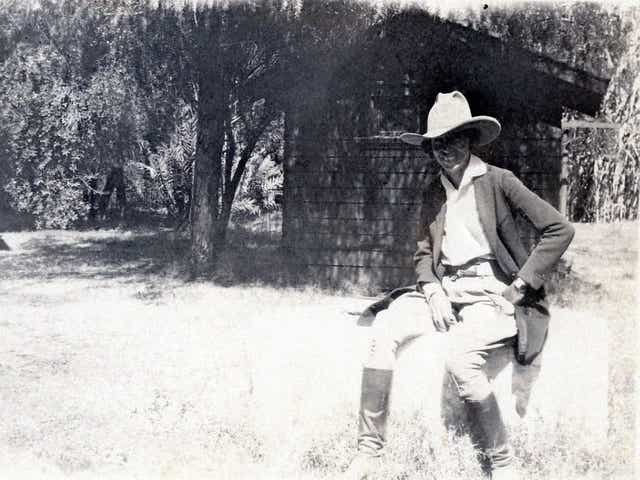
Harriet Cody, 1925, Palm Springs Historical Society.
The Struggle and Resilience
The Codys faced financial challenges, and their Hollywood home became a battleground. Tenants claimed their improvements exceeded the rent owed, leaving the couple in dire straits. Harriet’s determination, however, knew no bounds. She traded their Hollywood home for 80 acres of land in the south end of Palm Springs with pioneer developer P.T. Stevens. The Codys camped on this land until they completed their adobe house.
Bill Cody’s health deteriorated, requiring round-the-clock care. Harriet’s love and resourcefulness sustained the family. Food trays mysteriously appeared at their door, courtesy of their neighbor, Nellie Coffman, owner of The Desert Inn. Nellie’s kindness ensured the Codys’ survival during challenging times.
From Horses to History
Harriet Cody was an accomplished horseback rider skilled in English and Western traditions. Recognizing an opportunity, she established the first livery stable in Palm Springs on the property she acquired from Stevens. Tourists and movie cowboys alike sought her horses for riding adventures. Tom Mix and Jack Holt, famous film cowboys, frequented her stable while filming in the area.
Casa Cody: A Living Legacy
In 1916, Harriet Cody purchased a property adjacent to Nellie Coffman’s Desert Inn. She transformed it into Casa Cody, a charming adobe-style hotel that still stands today. Casa Cody welcomed guests from all walks of life, including artists, writers, and Hollywood stars. Its rustic elegance and warm hospitality captured the essence of Palm Springs. Still open, this is the oldest continually operated resort in Palm Springs.
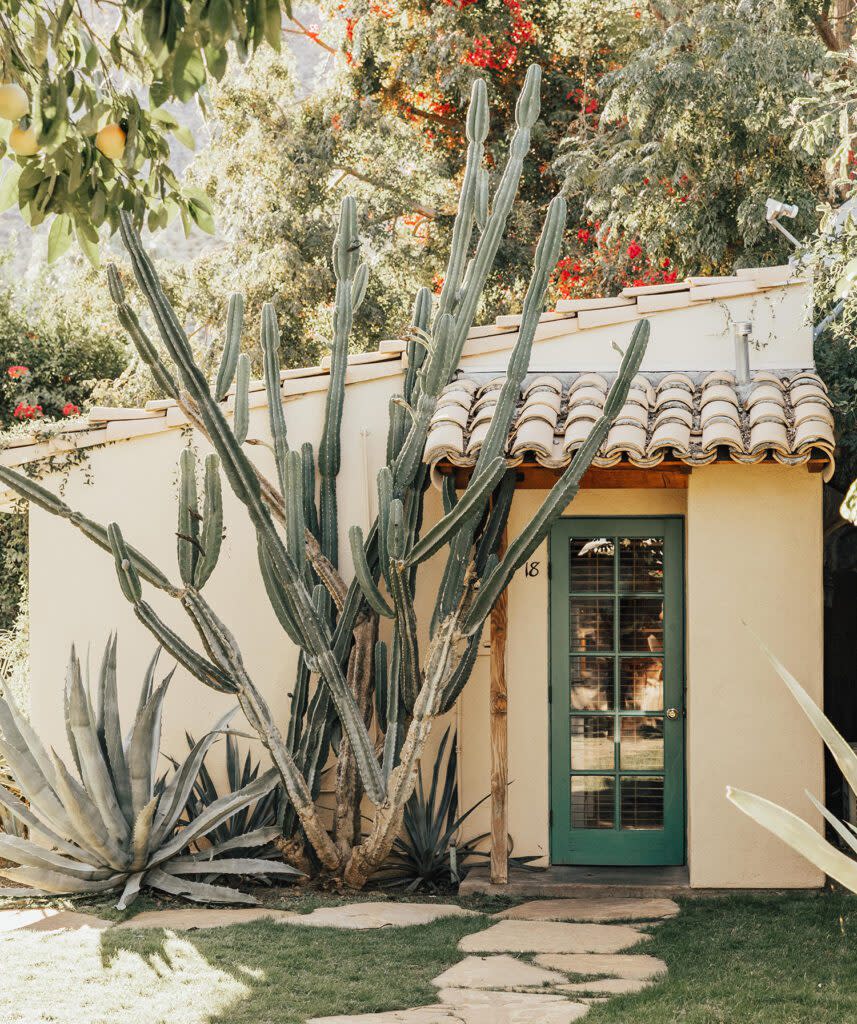
Against all odds, these women carved out a thriving community from the unforgiving desert. Their stories inspire us to honor their memory and recognize the strength of the female pioneers who shaped Palm Springs. As we bask in the warm desert sun, let us remember their enduring legacy and celebrate the indomitable spirit of these trailblazers.
Casa Cody Gets New Life
Black Pioneers of Palm Springs
History of the Bob Hope House
From Sacred Space to Center Stage
- 8 min read
Transforming Frey’s Desert Gem into Dezart Performs Playhouse…
The Plaza Theatre: A Star Returns to the Spotlight
- 12 min read
Built in the striking early Spanish-style architecture, The Plaza…
La Plaza: The Heart of Historic Palm Springs
- 8 min read
The Vision of Julia Carnell Julia Carnell, a philanthropist and…
Growing Up Mattel- A Palm Springs Toy Story
- 11 min read
Mink stoles and martinis. A 6-year-old with Unlimited Toys. Add Mattel…
Live Like a Star: Rent a Hollywood Home in Palm Springs
- 7 min read
Palm Springs began as a place of healing, prized for its warm, dry air…

